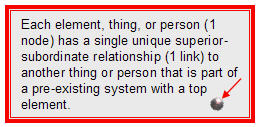| Network Myth #1 is that networks are flat. They are not. They are multi-leveled. All networks and virtual teams are hierarchical in the scientific sense. Even the simplest networks are made up of interacting parts that are themselves complex—people or groups. |
Hierarchy is the most general principle of general systems theory, but only in one sense of hierarchy, the organizing sense. The entry on "hierarchy" in Wikipedia provides an excellent summary of the crucial distinction in two uses of the word. Both have the same logical structure.
- Ranking, the most socially common meaning of hierarchy, is a system of higher-lower relationships, where high is usually judged as better than lower.
- Organizing, the second meaning is the scientific one, the sets-within-sets, parts-within-wholes-within-larger-wholes, sense of hierarchy.
|
| Ranking Hierarchy |
| "The first use of the word "hierarchy" cited by the Oxford English Dictionary was in 1880, when it was used in reference to the three orders of three angels as depicted by Pseudo-Dionysius the Areopagite. Pseudo-Dionysius used the word both in reference to the celestial hierarchy and the ecclesiastical hierarchy [1]. His term is derived from the Greek for 'Bishop' (hierarch), and Dionysius is credited with first use of it as an abstract noun. Since hierarchical churches, such as the Roman Catholic and Eastern Orthodox churches, had tables of organization that were "hierarchical" in the modern sense of the word (traditionally with God as the pinnacle of the hierarchy), the term came to refer to similar organizational methods in more general settings." |
| Organizing Hierarchy |
| "A hierarchy can link entities either directly or indirectly, and either vertically or horizontally. The only direct links in a hierarchy, insofar as they are hierarchical, are to one's immediate superior or to one of one's subordinates, although a system that is largely hierarchical can also incorporate other organizational patterns. Indirect hierarchical links can extend "vertically" upwards or downwards via multiple links in the same direction. All parts of the hierarchy which are not vertically linked to one another can nevertheless be "horizontally" linked by traveling up the hierarchy to find a common direct or indirect superior, and then down again. This is akin to two co-workers, neither of whom is the other's boss, but both of whose chains of command will eventually meet. " |
Basic hierarchy relationship |
 |
Organizations have a core that is a nested sets of whole-parts, a containment hierarchy. This fundamental structure of complex systems is the basic classification system that holds the whole together.
|
“A containment hierarchy is a collection of strictly nested sets. Each entry in the hierarchy designates a set such that the previous entry is a strict superset, and the next entry is a strict subset. (See also: Taxonomy.)”
|
Wikipedia definition of hierarchy makes crucial distinction of two forms: ranking and organizing
"A hierarchy (in Greek: εραρχία, derived from ερός — hieros, 'sacred', and ρχω — arkho, 'rule') is a system of ranking and organizing things or people, where each element of the system (except for the top element) is subordinate to a single other element." |
| The term ‘hierarchy’, meaning ‘the rule of Bishops’, relates to a ranking system with God at the top. While the ranking meaning obscures the more fundamental pattern of the organizing hierarchy, there is a pinnacle--a top element, root, whole, source--in both types of hierarchy |
|